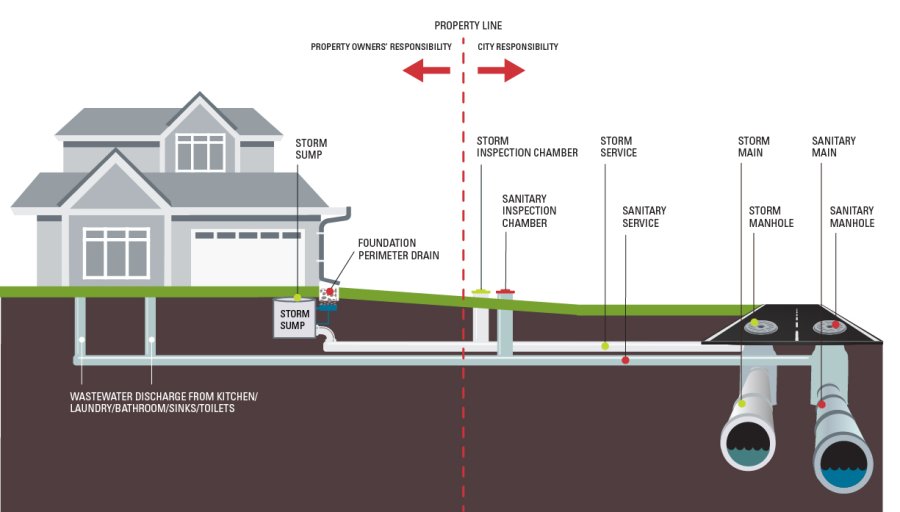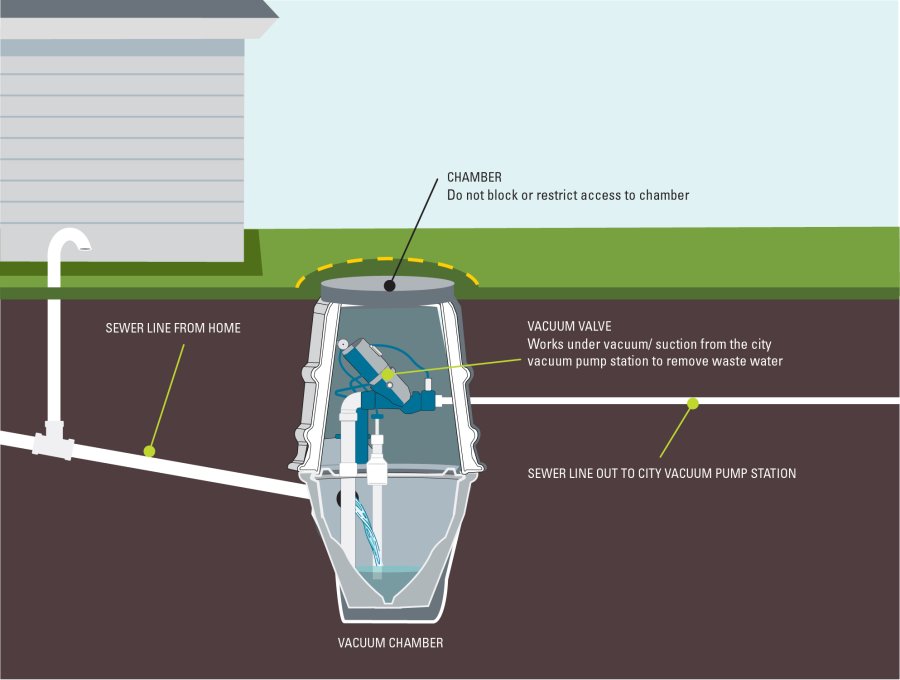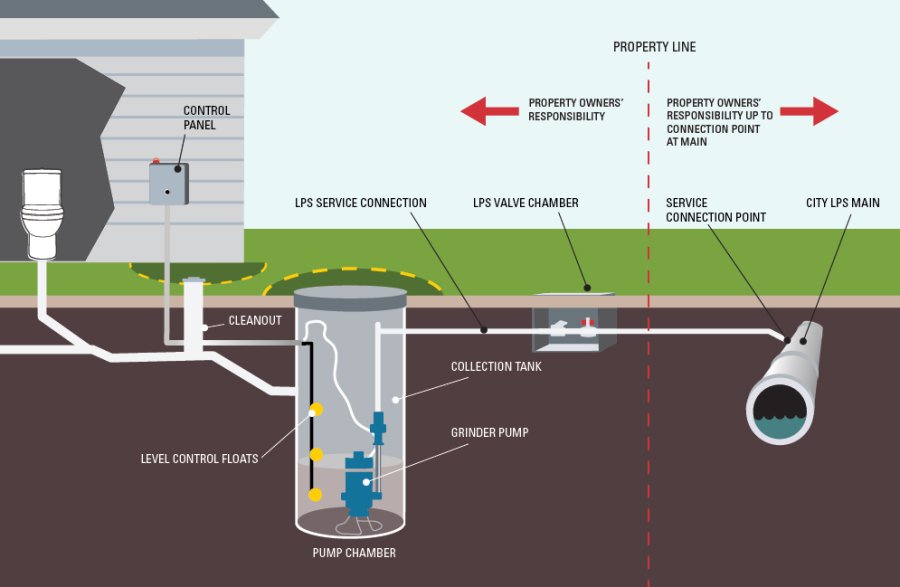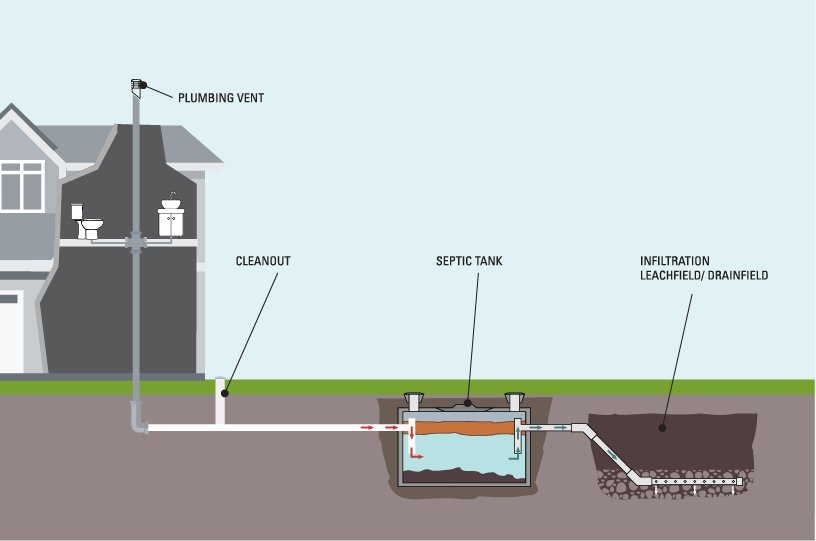Sanitary Sewer Maintenance for Property Owners
See how to keep your sanitary service connection clear & working properly.
Wastewater can have a major impact on our homes, businesses, and environment if the systems that carry wastewater are not maintained.
Property owners are responsible for all sewer infrastructure up to property line (unless stipulated in certain conditions where they may be responsible up to the mainline in Right of Way, third party agreements, or low pressure systems and pump connections).
Identify which system you have, and learn how to maintain it properly:
Gravity Sewer Systems
The most common system in Surrey. Gravity systems rely on slope and grade to help channel wastewater or storm water away from a home to sewer mains.
Storm foundation perimeter drains
Window wells and foundation perimeter drains are connected to the property storm sump which acts as a cleanout and access point for debris to be cleaned and maintained by the property owner. The water then flows into the city storm main through an inspection chamber (if available).
Vacuum Sewer Systems
Vacuum systems are used in areas which are beyond the reaches of the City’s gravity sanitary system or where soil conditions or topography are not suitable for a gravity system.
Each property with a vacuum system has a vacuum valve chamber. Wastewater from the building enters this chamber under gravity. Then, vacuum suction from a city pump station carries the wastewater out to the city mainline.
If you hear a constant whistling or sucking sound from the vacuum valve chamber, or if you are experiencing a sewer backup:
- Immediately stop using plumbing fixtures (sinks, faucets, toilets, baths showers, etc.) in the building until the problem is fixed.
- Report it using our Report a Problem tool or call us at 604-591-4152.
Low Pressure Pump Systems (LPS)
The property owner is solely responsible for all infrastructure and maintenance related to an LPS system up to the service connection point at the City main.
This includes the pump system on their property as well as the pipe between the pump system and the City main. For systems built after 2005, the property owner is responsible up to the City mainline. Some newer service connections may have a gate shut off valve just off of the City main.
LPS systems are used in areas that are:
- Beyond the reaches of the City’s gravity sanitary sewer system;
- Not large enough to provide economic justification for a community sewage pump station; or
- Where soil conditions or topography are not suitable for a gravity sewer system.
The LPS system is made up of four key parts:
- A pump chamber with one or two grinder pumps, located on private property. The pump chamber can be located inside or outside the home. Wastewater from the home or building enters this chamber and is then pumped out through the service connection to the City’s LPS main. The City LPS main conveys the wastewater under pressure to a City gravity sanitary sewer main.
- A valve chamber located on private property. This chamber contains a shut-off valve to close off the service connection if it needs to be repaired. It also contains a backflow check valve to prevent wastewater in the City’s LPS main from entering the home’s private pump chamber.
- A shut-off valve at the connection point between the service connection and the City’s LPS main. This valve remains open unless it needs to be closed to repair the service connection or pump on the property. Some older service connections may not have this.
- A control panel for the pump. This panel is usually installed either on or within the building or on a nearby pole.
Sometimes, a combination of LPS and gravity or slope is used. For example, a bathroom in the basement of a home that is below grade of City infrastructure will need to pump wastewater to the point where gravity or a slope can channel the discharge to City mains.
LPS systems require electricity to be able to operate and need annual maintenance for equipment such as grinder pumps. Proper maintenance helps prevent any interruption in service and avoid costly sanitary sewer backups and damages.
LPS system maintenance
Hire a certified plumber or contractor to look at your LPS system once a year. The service should include:
- Service connection cleaning (flush with water, like pressure washing)
- Check the pump & control panel to make sure all the parts are working
- Remove any material that may be stuck in the pump or pump chamber
- Check that the shut-off and backwater valves are working properly
- Pull the pumps and clean the intake grill and replace any defective or worn parts
Read the operation & maintenance manual that you received when your LPS system was installed or when you purchased your home. The manual includes:
- Pump make and model details
- Control panel and alarm information
- Alarm warning description and how to respond
- Warranty information and servicing procedures
- List of products and materials that should not be sent into the sanitary sewer system and pump chamber
Septic Systems
Septic sewer systems are used in areas and situations where there is no sewer or city infrastructure available like farmland, low lying and remote areas.
Septic systems include large holding tanks located on the property to hold solids and wastewater which are cleaned when full by vacuum trucks. The residual water is channeled to a leach field—or drain field—where it discharges into the ground.
Septic systems are the property owner’s responsibility. Age, and poor maintenance can lead to costly tank leaks and sewer overflow.
Check COSMOS to see if your property may be on septic. If there is no City sewer infrastructure nearby or if you do not pay an annual sewer tax your property may be on septic.
Contacts for Septic Systems
Enforcement of onsite septic sewerage systems is by the Fraser Health Authority.
Contact the Population Health Call Centre at 604-587-3936 and request to be connected to an environmental health officer in the Water and Land Program for health and safety concerns or complaints about:
- Onsite sewerage or septic tank failure
- Sewer overflows on private property
You can also email HPLand@fraserhealth.ca or contact the local Fraser Health Authority Surrey Health Protection Office at: 604-930-5405
Keep Your Sewer System Healthy
Do not pour fats, oils or grease down the drain
Fats, oils and grease will harden and stick to the sewer pipes. Running hot water at the same time will not stop fats, oils and grease from sticking to the sewer pipes.
Let fats, oils and grease begin to harden in your cookware (pots and pans). Then use a paper towel to wipe it off and put the paper towel in your compost bin.
If you prefer to clean your cookware right away, pour fats, oils and grease in a compostable container and put the container in the compost bin.
Don't flush personal hygiene items
This includes baby and personal wipes (even if they claim to be flushable or biodegradable), paper towels, make up removal pads, tampons and tampon applicators, sanitary napkins, condoms, disposable diapers, bandages, syringes, razor blades, medications, or other non-biodegradable products.
These items can clog sanitary sewer pipes, as well as the pumps at the City’s pump stations. Put them in the garbage instead. Find out how to correctly get rid of organics, recyclables and garbage by reading about the City’s waste collection program.
Use a strainer for your sink, tub and shower drains
Strainers are inexpensive and prevent food, hair and other items from going down the drain and possibly clogging your service connection. Put collected items in your garbage or compost bin instead.
Do not plant trees, shrubs or other large plants over your service connection
Trees and plants like water, and their root systems can grow into your service connection pipe through joints or cracks in the pipe.
Keep wastewater and stormwater separate
Direct your roof downspouts to your lawn, not to your storm perimeter drain or sanitary or storm service connection.
Rainwater and groundwater that makes its way into the sanitary sewer system has a major impact on the sewer’s ability to carry wastewater. These cross connections can lead to significant damages to the environment and excessive fines and prosecution from the City and Provincial Fisheries and Health Authorities.
Stormwater is surface rainwater, melted snow or water that runs off our roofs, driveways and roads rather than soaking into the ground. Storm systems convey stormwater away from buildings and discharge directly into local storm mains and watercourses such as creeks, streams or rivers.
Sanitary and storm systems must be kept separate to avoid contamination and unnecessary treatment of clean storm water in wastewater treatment plants. This can increase costs and place an extra unnecessary burden on the treatment system. Studies have suggested that up to 70% of the stormwater in a sanitary sewer system comes from private property.
There are municipal bylaws which dictate the installation, use, maintenance and enforcement of storm and drainage water systems. The City of Surrey’s Stormwater Drainage Regulation Bylaw No. 16610 lists the roles and responsibilities for both property owner and the City.
See more about stormwater in Surrey
Hire a plumber to video your service connection
The plumber will place a small camera in the service connection (usually by temporarily removing a toilet or other plumbing fixture) and the camera will take a video of the pipe as it travels from your home or building to the City's sanitary sewer system.
The video can tell you if there are any issues with your service connection (for example, if the pipe is broken or something is blocking it).
Use your compost bin for food waste, rather than using a garburator
The City does not encourage the use of garburators. Garburators add excess water and food waste to the sanitary sewer system. Food waste should go into your compost bin instead. Adding food waste to the sanitary sewer system can also cause a blockage if it attaches to hardened fats, oils and grease, tree roots or sediment in the sewer pipe.
Do not pour restrictive or prohibited waste down the drain
This includes paint, engine oil, pesticides, cleaners, or other chemicals. See the City’s Sanitary Sewer Bylaw No. 16611 for a list of restrictive and prohibited wastes.
Fix or replace leaky plumbing fixtures
Leaky (dripping) fixtures in your home such as toilets, taps and showerheads add a lot of water unnecessarily to the sanitary sewer system. They are also wasting clean water and energy. Fix or replace toilets, taps or showerheads that are leaking. Also consider installing low flow toilets or showerheads to save water.
Find out more about your maintenance responsibilities in the City’s Sanitary Sewer Bylaw No. 16611. You are responsible for all costs to maintain and repair the service connection within your property.
Sanitary and Storm Gravity Inspection Chamber
Your gravity system for your property, in most cases, has a sanitary and storm inspection chamber. This chamber is an access point or cleanout for maintenance and inspection. Usually, they are located 300mm (1ft) onto City property but sometimes are private in certain Right of Way or Easement/Backyard conditions.
Inspection chambers consist of a tee, riser pipe and locking collar and lid.
Do not bury inspection chambers. It is the homeowner’s responsibility to ensure inspection chambers are exposed and accessible for City crews.
If your inspection chambers are not visible or accessible:
- Use COSMOS to locate your property’s utilities' (locations and measurements are not always 100% accurate).
- Check to see if there is a stamping or marked location on the curb or sidewalk:
- S = Sanitary
- D = Drainage
- W = Water
- Check neighbouring properties so see if their chambers are visible and where they are located to get an approximation of City property line and chamber location.
Inspection Chamber Covers
Protective covers are required when the sanitary or storm sewer inspection chamber is in a travelled area or within 2m of a driveway. If the inspection chambers are not protected and become damaged, a sanitary or storm backup into your home is possible resulting in significant property damage.
The property owner is responsible for the installation, maintenance, and ease of access of the inspection chamber protective cover. The City of Surrey is not responsible for any remediation or restoration work to the driveway or letdown of the property during or after the installation of the protective cover. This includes but is not limited to asphalt, concrete, paving stones, vegetation, gravel, decorative rock or other features.
Protective covers can be obtained from local suppliers. These include:
- cast iron driveway boxes
- nelson valve body boxes and lids
- MR.10 valve box and locking lids
- brooks concrete meter boxes and metal lids
Installation of a sewer inspection chamber protective cover does not constitute acceptance or approval by the City of the illegal widening of a driveway. The City will still consider the residence as being in non-compliance and in contravention of the maximum legal width of a single-family residential driveway as per Surrey By-law 13007-Section 81.
How to Lower Your Inspection Chamber
To ensure your inspection chamber is exposed and easy to access, we can lower your sanitary or storm inspection chambers for free. We use a special tool to lower the riser pipes in order for you to be able to install protective covers such as meter boxes or MR 10s.
Inspection chambers can also be lowered in the grass, level to the ground, to prevent any tripping or possible issues with lawnmowers.
We can only lower inspection chambers on City property. Private cleanouts or storm sumps are the responsibility of the homeowner as are meter boxes and MR 10 protective covers.
Call 604-591-4152 or use our report a problem tool to request this service.
Wastewater Management at Food Sector Establishments
Metro Vancouver, member municipalities, local businesses and food associations have put together a Code of Practice for Wastewater Management at Food Sector Establishments. The code outlines business owners and employee requirements to capture fats, oils and grease.
See more about grease interceptor requirements for food sector establishments.



